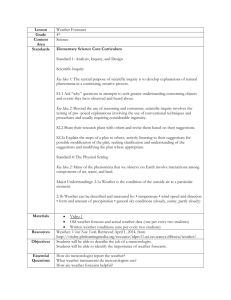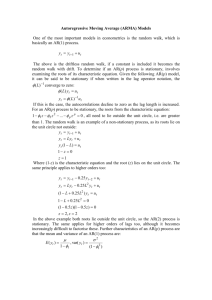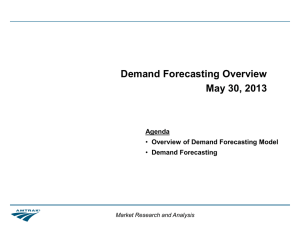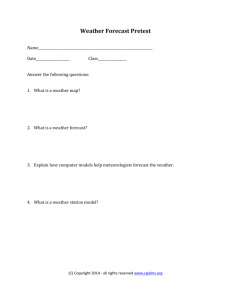Executive summary
advertisement
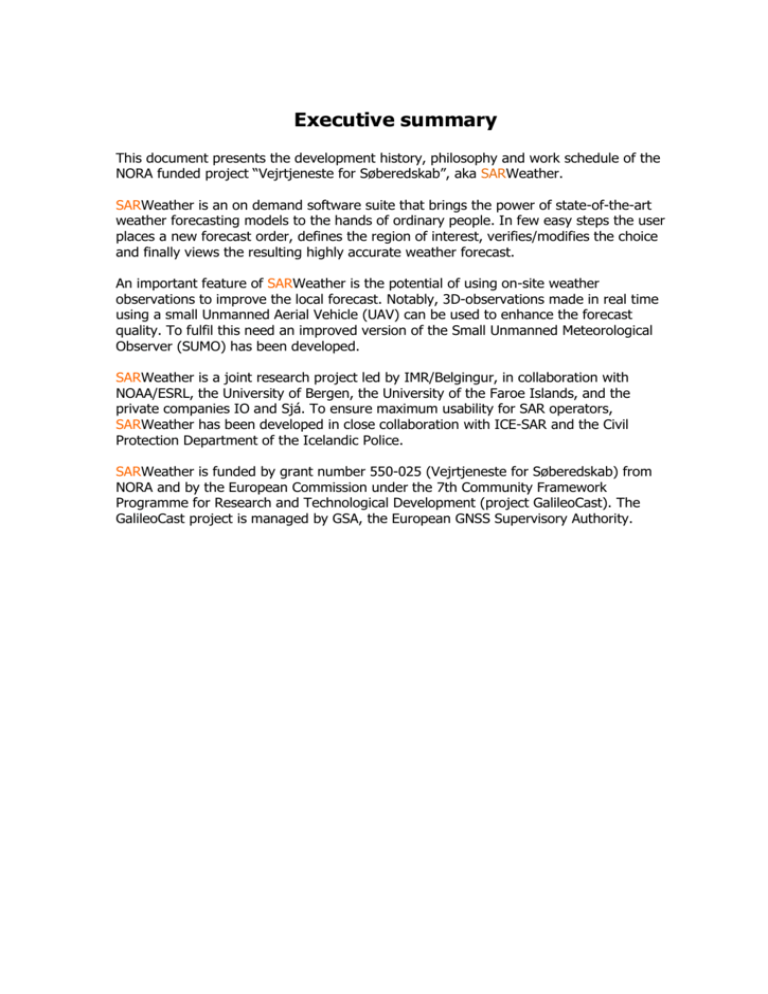
Executive summary This document presents the development history, philosophy and work schedule of the NORA funded project “Vejrtjeneste for Søberedskab”, aka SARWeather. SARWeather is an on demand software suite that brings the power of state-of-the-art weather forecasting models to the hands of ordinary people. In few easy steps the user places a new forecast order, defines the region of interest, verifies/modifies the choice and finally views the resulting highly accurate weather forecast. An important feature of SARWeather is the potential of using on-site weather observations to improve the local forecast. Notably, 3D-observations made in real time using a small Unmanned Aerial Vehicle (UAV) can be used to enhance the forecast quality. To fulfil this need an improved version of the Small Unmanned Meteorological Observer (SUMO) has been developed. SARWeather is a joint research project led by IMR/Belgingur, in collaboration with NOAA/ESRL, the University of Bergen, the University of the Faroe Islands, and the private companies IO and Sjá. To ensure maximum usability for SAR operators, SARWeather has been developed in close collaboration with ICE-SAR and the Civil Protection Department of the Icelandic Police. SARWeather is funded by grant number 550-025 (Vejrtjeneste for Søberedskab) from NORA and by the European Commission under the 7th Community Framework Programme for Research and Technological Development (project GalileoCast). The GalileoCast project is managed by GSA, the European GNSS Supervisory Authority. Table of contents 1. INTRODUCTION ...................................................................................................... 3 2. PROJECT OUTLINE ................................................................................................ 4 3. SERVICE IDEA ........................................................................................................ 7 4. DEVELOPMENT AND PROGRESS......................................................................... 7 5. SERVICE ARCHITECTURE, MAIN COMPONENTS AND INTERFACES ..............12 6. ON THE USE OF EGNOS AND EDAS FOR V2-SUMO ..........................................21 7. CONCLUSIONS ......................................................................................................22 8. REFERENCES ........................................................................................................22 1. Introduction It is rather the rule than the exception that rescue missions and search operations for missing people are initiated in extreme weather conditions. In any case, such missions are very dependent on the weather forecasts as the safety of the field personnel must be secured in the best possible manner. Search And Rescue (SAR) operators and personnel work in extreme conditions, where better and more timely information is of paramount importance. New methods for data assimilation and nowcasting are under constant development and aim at providing increasingly accurate weather forecasts on the scale of minutes and horizontal scales of few hundred meters. Obtaining the extra meteorological observations needed as input to these methods can however be tricky in remote areas or regions severely affected by natural catastrophes. The range of UAV1 flying meteorological observatories is a vital addition to the toolbox. Increasingly robust aircraft models can be deployed at a well-defined extra cost, with current weather conditions, in particular wind speed, being the determining factor. Meteorological observatories may even be retrofitted on SAR reconnaissance drones. The primary object of this project was to build a system that provides customers with a user friendly, web based interface that produces high-resolution weather forecasts for any location worldwide. The product described here has been named SARWeather and is currently being pushed to the market on a number of levels. The SARWeather system has four main features: Weather forecast can be ordered for a specific region (up to some maximum size, 100x100 km initially). The forecast provided are at a very high resolution (1 km spatial, 15 minutes temporal). Possibility to browse weather conditions up to 30 days prior to current date for a region of interest2. Integration with other services and devices. On-site data assimilation ingesting locally observed mobile or hybrid 2D or 3D observations as an option for larger areas with poor or no infrastructure, or greater need for accuracy. Disasters and weather are closely linked and the need for accurate weather forecasts is very well understood within the SAR community. With SARWeather, the users themselves define the forecast area and the system produces very-high-resolution forecasts within minutes of placing an order. The forecasts are updated automatically for as long as the operation lasts. Actual weather information prior to a disaster, incident, or situation, can be browsed for the area as it can help determining the possible behaviour, or reaction, of the affected persons, properties or resources. This module is still under development. 1 2 Unmanned Aerial Vehicle – UAV. Under development. 3 This first version of SARWeather only focuses on atmospheric modelling and forecasts. However, steps have been taken in order to assess the feasibility of including forecasts of waves and currents in future versions of SARWeather [1]. The main findings were that the operational NWW3 forecasts, run by NCEP/NOAA (National Centers for Environmental Prediction/National Oceanic and Atmospheric Administration, USA) are found to be too coarse for the coastal area around the Faroe Islands. The results indicate that the best (cost/benefit) procedure would be to run a regional wave model with high resolution winds and using NWW3 parameters as a crude boundary forcing. High resolution nested wave models could thereafter be placed within this model as a part of SARWeather. 2. Project outline The “Vejrtjeneste for Søberedskab” project, aka SARWeather, is funded by grant number 550-025 from NORA and by the European Commission under the 7th Community Framework Programme for Research and Technological Development (project GalileoCast). The project is lead by Institute for Meteorological Resarch (IMR) in close collaboration with scientists at the University of Bergen (UoB), the University of the Faroe Islands (UoF), and at the Earth System Research Laboratory of the National Oceanic and Atmospheric Administration in Boulder, USA (NOAA/ESRL). Functional specifications and user tests where done in partnership with the Iceland Search And Rescue association (ICE-SAR) and the Civil Protection Department of the Icelandic police (CPD). Web design and coding was done by IO software company (IO) and web design consultancy was in the hands of Sjá – viðmótsprófanir (Sjá). Redesign and development of the unmanned aerial vehicle called “SUMO” was done in collaboration with specialists at Síminn, telecommunication company, and students and scientists at the Reykjavík University. History of SARWeather The history of SARWeather is shown schematically in Figure 1. The idea emerged in early 2007 and was introduced to CPD and ICE-SAR in April that year. In August 2007 the FloHof observation campaign was around Hofsjökull ice cap in central Iceland. It was during this research project that the SUMO airplane was first used in Iceland and it’s potential for improving local forecasts was realized. The next years where mainly used to gain momentum for the idea and secure funding. The necessary funds are secured in 2009 and coding starts in the autumn. In January 2010, after the devastating earth quake in Haiti, IMR was approached by Mr. Gísli Ólafsson, than team leader of ICE-SAR in Port-au-Prance, and asked to set up a high resolution forecasting system for Haiti. This was in a way a turning point for the project, in less than two hours IMR specialists had set up the system and the first forecast was made available on the web. The same request was made by the UK SAR team to the UK Meteorological Office. The UK SAR team had to wait for 80 hours before having a dedicated forecasting system3. It was this short response time that made us fully realise the potential of SARWeather, once fully operational. What took two hours in January 2010, now takes only a few minutes. 3 Víðir Reynisson, head of CPD, personal communication. 4 2007-2008: Lobbyism, applications, etc. etc. 2007: Flight of the SUMO 2007: Idea emerges January 2010: Haiti 2009: Cash starts flowing Spring/summer 2010: Eruption in Mt. Eyjafjallajökull Spring 2010: USAR conference in Abu Dhabi 2009-2010: Code like the wind SARWeather May 2010: GDACS annual meeting Figure 1: A short history of SARWeather, more detailed information in text. SARWeather was promoted by Mr. Gísli Ólafsson at the Urban Search And Rescue conference in Abu Dhabi in April 2010. As a result IMR was offered to introduce the system at the GDACS4 annual meeting in Geneva in May. This was a great success, we are now in the process of integrating SARWeather with the GDACS global alert system. SARWeather was used for monitoring purposes during the Mt. Eyjafjallajökull eruption and for creating weather forecasts for Pakistan during the flooding events last autumn. The SARWeather system was promoted at the international conference and expo “RESCUE 2010”, held in Reykjavík in October 2010. It was at this event that collaboration with the Irish software company Decisions for Heroes (D4H5) was initiated. But D4H’s software solution is a collaborative rescue team management tool, that helps record and analyse rescue operations. Work is now being done in order to integrate SARWeather with the D4H solution. The most recent use of SARWeather has been in Libya and Japan, but the system is being used for running 1km forecasts for the area around Tripoli and for Fukushima in Japan. 4 http://www.gdacs.org - Global Disaster Alert and Coordination System, is a cooperation framework under the United Nations umbrella with the aim to consolidate and strengthen the network of providers and users of disaster information worldwide in order to provide reliable and accurate alerts and impact estimations after sudden-onset disasters and to improve the cooperation of international responders in the immediate aftermath of major natural, technological and environmental disasters. 5 http://www.decisionsforheroes.com/ 5 Various model setups – a case study A severe windstorm downstream of Mt. Öræfajökull in Southeast Iceland is simulated on a grid of 1 km horizontal resolution by using the PSU/NCAR MM5 model and the Advanced Research WRF model. Both models are run with a new, two equation planetary boundary layer (PBL) scheme as well as the ETA/MYJ PBL schemes. The storm is also simulated using six different micro-physics schemes in combination with the MYJ PBL scheme in WRF, as well as one "dry" run. Output from a 3 km MM5 domain simulation is used to initialise and drive both the 1 km MM5 and WRF simulations. Both models capture gravity-wave breaking over Mt. Öræfajökull, while the vertical structure of the lee wave differs between the two models and the PBL schemes. The WRF simulated downslope winds, using both the MYJ and 2EQ PBL schemes, are in good agreement with the strength of the observed downslope windstorm. The MM5 simulated surface winds, with the new two equation model, are in better agreement to observations than when using the ETA scheme. Micro-physics processes are shown to play an important role in the formation of downslope windstorms and a correctly simulated moisture distribution is decisive for a successful windstorm prediction. Of the micro-physics schemes tested, only the Thompson scheme captures the downslope windstorm. The results of this experiment are fully documented in a peer reviewed paper, published in Atmospheric Chemistry and Physics, in January 2011 [2]. Budget overview and deviations from original work plan Table 1 gives an overview of estimated and true cost of the project. Table 1: Estimated and true cost of the project. Acronyms are as follows: IMR – Institute for Meteorological Research IO – IO software company Sjá – Sjá viðmótsprófanir software company UoF – University of the Faroe Islands / Fróðskaparsetur Færeyja CPD – Civil Protection Department of the Iceland Police / Almannavarnadeild Ríkislögreglustjórans ICE-SAR – Iceland Search And Rescue association / Slysavarnarfélagið Landsbjörg 6 UoB – University of Bergen / Universitetet i Bergen NOAA/ESRL – National Ocean and Atmospheric Administration/Earth System Research Laboratory The main deviations from the original work plan regard the contribution of IMR. This is because the complexity of the forecasting system was increased considerably with the introduction of real-time integration of 3D observations from the SUMO airplane. The additional cost was met with co-funding from the GalileoCast6 project. Secondly, the design, development and user-tests of the system’s front-end were not as time consuming as originally thought (less number of PM’s from companies IO and Sjá). Thirdly, there was considerably less cost connected to travel and meetings. This is due to the fact that Dr. Bárður Niclasen was unable to visit Iceland in the autumn of 2009. Hence the kick-off meeting was held “in-house” and no travel cost fell on UoF. Further, due to the Mt. Eyjafjallajökull eruption, and the extra strain it put on ICE-SAR and CPD personnel during the summer of 2010, and the fact that the RESCUE 2010 conference was to be held in Reykjavík in October 2010, it was deemed unwise to spend resources to introduce the system to stakeholders in the Faroe Islands. Especially since a large number of said stakeholders would be attending the RESCUE 2010 conference, where SARWeather was being promoted. A more detailed break-down of the budget is found in the auditor report from Kjarni ehf. 3. Service idea SARWeather is a flexible, high-resolution weather forecasting system specially tailored to the needs of SAR (Search And Rescue) teams and rescue control centres. It includes a novel way of adding on-site weather observations to improve weather forecast quality. An important feature of SARWeather is the potential of using on-site weather observations to improve the local forecast. Notably, 3D-observations made in real time using a small Unmanned Aerial Vehicle (UAV) can be used to enhance the forecast quality. To fulfil this need an improved version of the Small Unmanned Meteorological Observer (SUMO [3]) has been developed in close collaboration with Reykjavík University. 4. Development and progress A functional demonstration version was available in late October at the RESCUE 2010 conference (http://www.icesar.com/category.aspx?catID=297). SARWeather is to be run operationally for the Icelandic SAR Coordination Centre in Q1 of 2011. Once an operational V2-SUMO is available (late Q2/early Q3 of 2011), SARWeather will reach it’s full potential. Summary of the development of SARWeather 6 Functional specifications worked out in collaboration with ICE-SAR and the Civil Protection Department of the Icelandic Police (CPD), August-November 2009. http://www.forecaconsulting.com/galileocast/doku.php?id=main_page 7 ◦ ◦ ◦ ◦ ◦ ◦ ◦ ◦ 7 Forecasting system development 2009-2010. Infrastructure for scalability: Negotiations with Penguin Computing Inc. (http://www.penguincomputing.com) was done in the summer of 2010. Collaboration with GreenQloud (http://www.greenqloud.com) established in late 2010. On-site testing of meteorological data acquisition using the SUMO system was done in the summer of 2009. On-site meteorological data and communications – sending data in real time from the SUMO system was done in the summer of 2010. Test flight with the modified SUMO system was done in July 2010. Data transmission was successful from all three flight locations. Building an improved SUMO airplane (V2-SUMO): Q3 of 2010 to Q1/Q2 of 2011. The upgraded SUMO system is being finalized and integrated with the data base. It is expected that a fully operational V2-SUMO will be ready in late Q2/early Q3 of 2011. All subcomponents of the V2-SUMO system have been individually tested with success in-flight data transmission data retrieval and storing in data base use of SUMO data from data base, as input to WRF's data assimilation system data shown to improve the forecast Data assimilation of meteorological data and other techniques for forecast improvement: 2009-2010. Web interface: Design 2009, implementation summer 2010. End-user tests started in August 2010. Feasibility study of including forecasts of waves and currents in future versions of SARWeather finished in summer of 2010. Peer reviewed paper on the WRF model setup, published in Atmospheric, Chemistry and Physics in January 2011. A long term service contract between IMR, ICE-SAR, CPD (Civil Protection Department of the Icelandic Police), and 112 in Iceland is being negotiated. IMR will initially provide SARWeather as a 24/7 service to these bodies. Once V2SUMO is operational, SARWeather will be brought to it’s full operational status. SARWeather has been officially included as a GDACS contributor. First to be used in upcoming exercises, but then with the idea to fully integrate it into GDACS. To assist with this process, UNOSAT is to become a Beta-tester of the system. SARWeather was promoted at the RESCUE 2010 conference with quite a success. Potential leads are being followed up on. SARWeather is being integrated into the D4H7 software solution. This opens up the market to hundreds of individual SAR teams, worldwide. http://www.decisionsforheroes.com 8 Periodic development of SARWeather Period 1.7.2009-31.10.2009 R&D activities in quarter: Functional specifications worked out in collaboration with ICE-SAR and the Civil Protection Department of the Icelandic Police (CPD). Standardization of data from UAV's (like the SUMO airplane) in order to optimize NWP forecasts through data assimilation. Development of data base for UAV data. Development of a novel NWP system for rescue operations purposes by: o increasing the flexibility of current forecasting system in setting up new forecast domains o implementing data from UAV's into the NWP's data assimilation system o speeding up pre- and post-processing of data through parallelization Dissemination activities in quarter: Interview on the SUMO airplane on national television. Representation on the Nordic Climate Solutions (NCS) conference in Copenhagen. Market development and exploitation activities in quarter: Informal meetings with stakeholders at the NCS conference in Copenhagen. Participation in the UH20 marketing project of the Icelandic Trade Council. Informal meetings with stakeholders from the Scandinavian energy sector. Continued dialog with local stakeholders. Period 1.11.2009-31.1.2010: R&D activities in quarter: Continued standardization of data from UAV's (like the SUMO airplane) in order to optimize NWP forecasts through data assimilation. Continued development of data base for UAV data. Continued development of a novel NWP system for rescue operations purposes. Dissemination activities in quarter: On the request of ICE-SAR personnel operating in Haiti, IMR set up an operational high resolution weather forecasting system for Haiti. The forecasts are updated four times a day and are free of charge for anyone to use. Market development and exploitation activities in quarter: Participation in the UH20 marketing project of the Icelandic Trade Council. Continued dialog with local stakeholders. Participation in the A-Board project at the Copenhagen Business School (CBS). 9 Period 1.2.2010-30.4.2010 R&D activities: Work on assessing the feasibility of including forecasts of waves and currents in future versions of SARWeather starts. Continued standardization of data from UAV's (like the SUMO airplane) in order to optimize NWP forecasts through data assimilation. Installation and testing of the WRF's 3D VAR assimilation system. Implementation of a new high-resolution DEM data (dx=30meters) within WRF. Continued development of data base for UAV data. Continued development of a novel NWP system for rescue operations. Dissemination activities in quarter: SARWeather has a booth at the MIT conference in Reykjavík, Iceland. The http://www.sarweather.com web page is launched. SARWeather leaflet is created and distributed domestically and at the international Urban SAR conference in Abu-Dhabi. Market development and exploitation activities in quarter: Participation in the UH20 marketing project of the Icelandic Trade Council. Participation in the A-Board project at the Copenhagen Business School (CBS). Continued dialog with local and international stakeholders Member of ICE-SAR introduces SARWeather at an international conference for Urban SAR in Abu-Dhabi. SARWeather concept introduced to Swedish SAR group in Helsingborg. Other activities in quarter: After the USAR conference in Abu-Dhabi, IMR was offered to present SARWeather at GDACS (Global Disaster Alert and Coordination System – http://www.gdacs.org) annual working group and stakeholder meeting, held in Geneva 4-7 May. Period 1.5.2010-31.7.2010 R&D activities: User testing of SARWeather start. Work on assessing the feasibility of including forecasts of waves and currents in future versions of SARWeather is finished, technical report written and delivered [1]. Work on standardization of data from UAV's continues. To ensure real time data retrieval from the SUMO airplane IMR starts working on enhancing the already existing model. This is done in close collaboration with Reykjavík University and Síminn, Iceland's largest telecommunication company. The goal is to be able to send observational data from the SUMO in real time via 3G/GSM modem, and store the data in a data base. Consequently, the data can be used for data assimilation purposes in a straight forward manner. 10 Testing of the WRF's data assimilation system continues, focus shifts from using 3D/4D-Variational methods towards the Four Dimensional Data Assimilation (FDDA) method. Development and coding of the SARWeather backend, i.e. how the web interface communicates with the WRF weather forecasting system. Dissemination and market development and exploitation activities: After the Urban SAR conference in Abu-Dhabi, where the SARWeather concept was introduced, IMR was invited to attend the annual stakeholders meeting of GDACS (Global Disaster Alert and Coordination System – http://www.gdacs.org) in Geneva. At the meeting IMR presented the solution. It was decided that SARWeather should be tested within the GDACS consortium later this year. If the test results would be promsing, the solution would be recommended to become a permanent part of the GDACS “toolbox”, at the next annual stakeholders meeting. Other activities in quarter: Positive exposure of SARWeather through the GDACS consortium is a very promising as GDACS is held in high respect within the global Search And Rescue community. Period 01.08.2010 to 31.12.2010 Summary of main R&D activities: User testing of SARWeather continue. The main effort has gone into continuous coding of the SARWeather back-end, i.e. how the web interface communicates with the WRF weather forecasting system. Integration of real-time data from the SUMO plane, into SARWeather, has continued, as well as development of the V2 of the SUMO airplane at the Reykjavík University. Dissemination and market development and exploitation activities: Collaboration with UNOSAT/GDACS continues. SARWeather provided high resolution forecasts for Armenia during a virtual earth quake exercise. The importance of additional input data from the SUMO was recognized when UNOSAT/GDACS experts tried to predict the air born distribution of poisonous chemicals from a disrupted plant in the vicinity of the (virtual) earth quake epicenter. Soon after the exercise, IMR visited UNOSAT headquarters in Geneva. The visit strengthened the already good relationship between IMR and UNOSAT. IMR gave a talk on SARWeather at an international WRF symposium in Bergen, Norway in September. Further talks were given at the Engineering and Natural Sciences Research Symposium at the University of Iceland in early October and at a symposium held by the Icelandic Meteorological Society on 20 October. On 21 October the system was introduced to a group of stakeholders in connection with the Rescue 2010 conference. The Rescue 2010 conference and expo was held 22 to 24 of October in Reykjavík. IMR gave a lecture on SARWeather and IMR further had a booth at the 11 conference where people could test the system in real time. Five international SAR groups showed interest in testing the system and more groups have been in contact since via email. At the Rescue 2010 expo IMR touched base with an Irish software company called Decisions for Heroes (D4H) that makes web-base rescue team management, and analytical software. It has been decided to integrate SARWeather into the D4H software suite, giving IMR access to thousands of potential users. Issues and risks to the project: No major show stoppers for a successful implementation of SARWeather have been identified. Once an operational V2-SUMO is available, the full potential of SARWeather can be demonstrated. 5. Service architecture, main components and interfaces SARWeather and SUMO Weather forecasting system – components and interfaces SUMO data 3D-VAR or 4D-VAR SARWeather SUMO data via Obs Nudging www.belgingur.is post processing Figure 2: Schematic overview of the WRF modelling system showing where additional observations from the SUMO airplane can be ingested into the system. Adapted from the WRF modelling home page (http://www.mmm.ucar.edu/wrf/OnLineTutorial/Introduction/flow_WPS.htm). Figure 2 shows the flow chart for the WRF weather modelling system. The observational data from the SUMO can both be made part of the “Standard Obs Data” external data source category, shown on the left in the figure, or via observation nudging. It is this latter method that has been opted for in the SARWeather system. In addition, SARWeather has a tailor suited post-processing system shown on the flow chart. 12 On-site data acquisition and transmission Figure 3 shows the upgraded V2-SUMO system. In order to facilitate the 3G/GSM modem, needed to transmit observational data in real time, it was necessary to add a new computer to the original SUMO system (cf. Gumstix). An additional bonus feature is that the upgraded system now has two additional sensor interfaces. This opens up the possibility for a Gyro system (to help keep the plane level), a dust sensor to be used for measuring e.g. volcanic ash, or even a small camera. Figure 3: Schematics showing the upgraded V2-SUMO system. GNSS position connects to the original Tiny2 computer. The original transmission, i.e. wi-fi connection with the on-site laptop, is done through the Xbee module. The new, real time, long-range, data transmission is done through the UART modem. In order to integrate the new computer (cf. Gumstix) with the original SUMO hardware and software, considerable system modification had to be done. This work was done by Mr. Símon E. Vilhjálmsson, as part of his project in fulfilment of a B.Sc. degree in electric engineering at the Reykjavík University [4]. The greatest hurdle was to re-program the Gumstix microcomputer so it would communicate seamlessly with the original SUMO hardware. 13 The reason for using 3G/GSM system, instead of for example the Iridium system, is that 3G/GSM has both relatively good global coverage (cf. Figure 4 and Figure 5). It is also considerably cheaper, more power conservative and lighter than any Iridium solutions on the market. Figure 4: Global coverage of the 3G system, also known as UMTS - Universal Mobile Telecommunication System. Note that although a country is “red”, it does not indicate that 3G coverage is everywhere. See for example Fig. 4 of a detailed map of the 3G coverage in Iceland. Figure 5: Same as Figure 4, but a detailed map for Iceland (valid July 2010). Different colours indicate various data transfer capacity. 14 The new microcomputer (Gumstix) not only has to communicate with the original hardware, but also with the 3G/GSM modem (UART modem). This programming work was also done by Mr. Vilhjálmsson, and is documented in his B.Sc. thesis [4]. A number of test flights (cf. Figure 6) where conducted in July were the robustness of the in-flight data transmission system was verified. Figure 6: In July three test flights were conducted in order to test the in-flight data transmission potential of the new SUMO system. The combined 3G/GSM system proved successful at all three locations, i.e. in all cases either the 3G or the GSM connection could be used to transmit data to the data server. Locations of flight sites are shown with red X-es. The sites were chosen as to represent the widest range of available connection, ranging from very good (Heiðmörk) to very poor (Mýrarnar). There still remains to build a fully upgraded Version2-SUMO with all sensors connected to the new Gumstix microcomputer. Currently, only one of the original sensors has been connected and tested in-flight. Effects of 3D observations on forecasts To demonstrate the effects 3D observations from the SUMO-system can have on high resolution weather forecasts, data from test flights done on July 15 2009 have been used as input to the WRF modeling system. For this particular day and location, high resolution atmospheric simulations failed to produce north-easterly accelerated flow on the lee-side of Mt. Esja (900 m.a.g., SW-Iceland near Reykjavík), as was indeed 15 observed in the SUMO test flight as well as at the ground. Instead, the atmospheric models produced a fictious westerly sea breeze in the early afternoon. Figure 7 shows results from three different simulations done with the WRF system at 1 km horizontal Figure 7: Simulated surface wind speed [m/s] and direction (left panel), as well as N-S oriented cross section across Mt. Esja of wind speed [m/s], circulation vectors and isentropes [K] (right panel). Top row shows results from a standard simulation, middle row when data from one SUMO flight is used to nudge the simulation. The bottom row shows results from a simulation where observations from five consequential SUMO flights were used to nudge the simulation. All panels are valid at 15:00 UTC with simulation starting at 00 UTC on July 15, 2009. 16 resolution. Top row show the standard simulation where the model in only forced with initial and boundary data from a global forecasting model. When applying the SUMO observations, there is a considerable improvement in the quality of the simulated atmospheric flow and the character of the flow in the lee of Mt. Esja is correctly captured. On-demand computational resources It was intended to install the SARWeather system on the Penguin-On-Demand (POD), pay per use computing system (http://www.penguincomputing.com/). This was meant to ensure sufficient computing power to run many operations simultaneously. POD is a high-performance, scalable, on-demand High Performance Computing (HPC) environment with high-density compute nodes and direct attached high-speed storage. POD POD users have a persistent and secure compute environment that executes jobs directly on on the compute nodes’ physical cores. Both GigE and high performance Infiniband networks are networks are available as the compute nodes interconnect. Jobs run over a localized network network topology to maximize inter-process communication (minimum latency and maximum maximum bandwidth). Schematic of the system is shown in Figure 8. 17 Figure 8: Schematic showing the POD system. Taken from the web: http://www.penguincomputing.com/POD/HPC_as_a_service. 18 The collaboration with POD has unfortunately not been as fruitful as initially hoped for. It has been discovered that traditional HPC services may not be as scalable as we thought at first. To insure necessary computing power we are now investigating the possibility of running SARWeather on a computer cloud. To do so we have started collaborating with a company called GreenQloud (http://www.greenqloud.com), based in Iceland. GreenQloud currently provides the hardware to run the high resolution forecasts for Libya and Japan and we are finalizing the setup for SARWeather system intended for use by the Icelandic SAR Coordination Centre. GreenQloud will act as hardware provider for this service. 19 End user system Figure 9 shows the web interface of the SARWeather system. STEP 1 Define the area STEP 2 Confirmation STEP 3 View forecast Figure 9: The end user interface is very simple, consisting of three simple steps to set up and run 20 a high resolution weather forecast. In step one the user defines the forecast area. This can be done in two different ways: 1. Define the latitude and longitude values of the lower left and upper right corner points of the requested forecast domain 2. Define the latitude and longitude value of the domain, as well as the preferred radius After having defined the forecast domain, the user is requested to visually confirm his/her choice (step two). In the third, and final, step the resulting forecast is disseminated to a web page for the user to view. Model output can also be disseminated to an ftp server for further use. Integration of subcomponents Figure 10 shows the schematic overview of the full SARWeather modelling system, i.e. SARWeather plus the V2-SUMO. The V2-SUMO observer uses GNSS system for accurate flight plan, the V2-SUMO is controlled from a ground base (cf. Regular connection). Data from the V2-SUMO system is sent via 3G/GSM modem to a database. This database could also ingest hybrid observational data from a variety of sources. The observed data is integrated to the WRF pre-processing system and becomes part of the initial and boundary data used to improve the high resolution forecast. The model results are visualised on the same web page used to initiate the forecast. The data can also be streamed to other decision support software, e.g. GalileoActive8 or ArgGIS. Figure 10: Schematic overview of the SARWeather system. 8 http://dev.galileoactive.com/ 21 6. On the use of EGNOS and EDAS for V2-SUMO The European Geostationary Navigation Overlay Service (EGNOS) provides both correction and integrity information about the GPS system. As a satellite navigation augmentation system, EGNOS improves the accuracy of GPS by providing a positioning accuracy to within three metres. By comparison, someone using a GPS receiver without EGNOS can only be sure of their position to within 17 metres [5]. According to the EGNOS webpage [5] there are three types of services offered within the EGNOS/EDAS framework: Open service, with no guarantee of liability. Safety-of-life Service. Once certified, EGNOS will provide a valuable integrity message warning the user of any malfunction of the GPS signal within six seconds. Commercial service. Data will be disseminated through the EGNOS Data Access Service (EDAS). This dissemination is done through the internet, and not via satellite. From the SARWeather/V2-SUMO point of view the increased horizontal accuracy is of great importance as well as the possibility of the data integrity flag. It should be noted that even with the EGNOS/EDAS system, vertical resolution will not be sufficient for safe takeoffs and landings in full automatic mode. For that to become reality one would need to supplement the vertical resolution with guidance through barometric instruments. As the modified version of the SUMO is in a way a flying IP-number (via its 3G/GSM data link) it should be able to digest the EGNOS data through the EDAS system (cf. Figure 11). Figure 11: Overview schematics of the EGNOS/EDAS system. EDAS is a single point of access for the data collected and generated by the EGNOS infrastructure [6]. The geographical coverage of the EGNOS system extends to Europe and Northern Africa. As the use of UAV's (like the V2-SUMO) is strictly regulated in large parts of Europe (or not allowed at all) the benefits of the EGNOS/EDAS system will unfortunately be difficult to test unless the regulatory environment becomes less strict. 22 7. Conclusions A unique software solution that makes it simple for regular people to create highly accurate weather forecasts for any location worldwide and on demand. The first version of the on demand forecast system has been named SARWeather, and fulfils the demanding needs of search and rescue operators. Operational service of SARWeather for the Icelandic SAR Coordination Centre will start in late March 2011. SARWeather is to be a part of the GDACS system in Q3 of 2011. An important feature of SARWeather is the potential of using on-site weather observations to improve the local forecast. Notably, 3D-observations made in real time using a small Unmanned Aerial Vehicle (UAV) can be used to enhance the forecast quality. To fulfil this need an improved version of the Small Unmanned Meteorological Observer (SUMO) has been developed. A high resolution nested wave model is a viable addition to a future version of SARWeather and steps towards such implementation have already been taken by the current research consortium. 8. References [1] B. A. Niclasen, 2010: NWW3 as part of SAR-Weather: Initial investigation and thoughts on how to proceed. Náttúruvísindadeildin, Fróðskaparsetur Færeyja,Technical Report. ISSN 1601-9741. [2] Ó. Rögnvaldsson, J.-W. Bao, H. Ágústsson, and H. Ólafsson, 2011. Downslope windstorm in Iceland – WRF/MM5 model comparison, Atmos. Chem. Phys., 11, 103-120, DOI:10.5194/acp-11-103-2011. [3] J. Reuder, P. Brisset, M. Jonassen, and S. Mayer, 2008. SUMO: A Small Unmanned Meteorological Observer for atmospheric boundary layer research. 14th International Symposium for the Advancement of Boundary Layer Remote Sensing. IOP Conf. Series: Earth and Environmental Science 1 (2008) 012014. DOI: 10.1088/1755-1307/1/1/012014. [4] Símon Elvar Vilhjálmsson, 2010. Fjarskiptavæðing mannlausra flugvéla. Lokaverkefni í rafmagnstæknifræði B.Sc. Thesis for the partial fulfilment of a B.Sc. degree in electrical engineering. School of Science and Engineering, Reykjavík University, Iceland. In Icelandic. [5] EGNOS webpage: http://www.egnos-portal.eu/index.cfm?objectid=B73432D1-AC0C-11DEAAA50013D3D65949. [6] EDAS webpage: http://www.gsa.europa.eu/go/egnos/edas. 23


